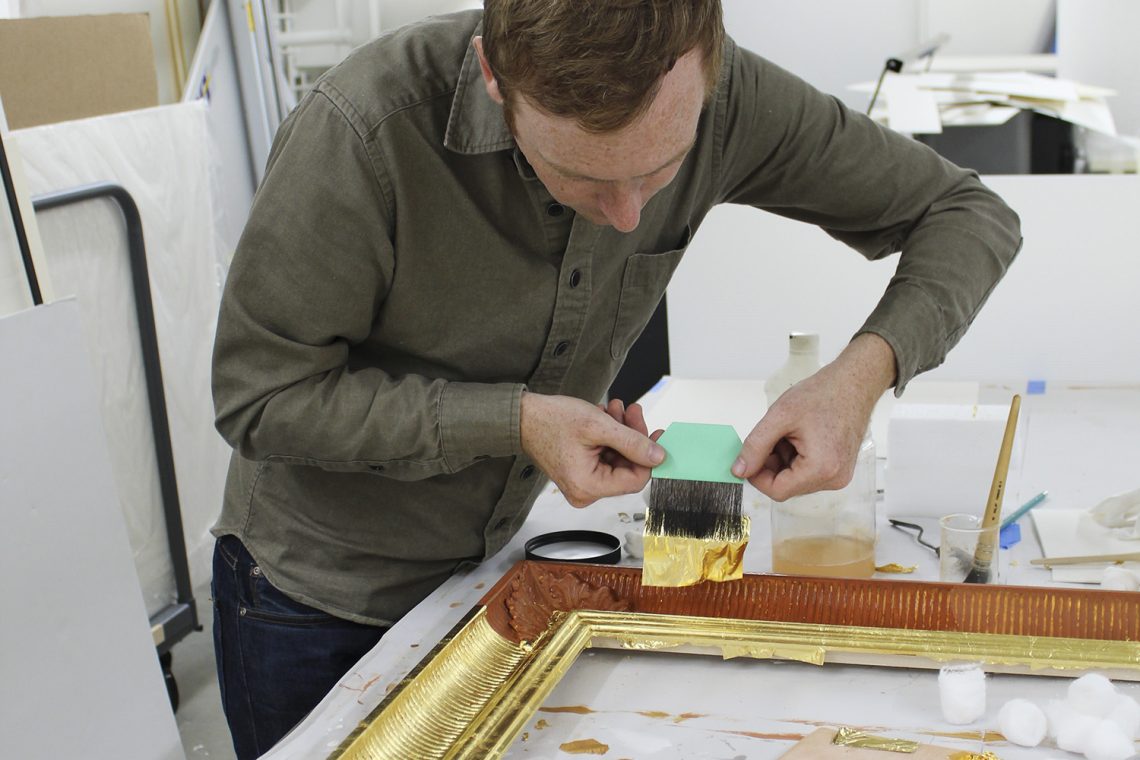 Photo: Sandra Feder
Photo: Sandra Feder
Gilded frames enhance paintings from the Gilded Age at the Cantor Arts Center
Museum framer creates gilded frames using squirrel hairs, agate stones and recipes found in a 15th-century manual.
During the holiday season, the whole world seems more luminous and shinier, from sparkling lights to beautifully wrapped gifts. Sparkle and shine are also on view at Stanford’s Cantor Arts Center this season, particularly in the exhibition Painting Nature in the American Gilded Age. That’s because the word “gilded” in the title of the exhibition means something special to framer Albert Lewis.
“I have been fascinated by the process of water gilding for over a decade,” he said. As a framer at the Cantor, Lewis is responsible for hand-crafting the frames that showcase works of art, taking care to make sure the style of the frame reflects the period of the artwork.
In this case, both Lewis and exhibition curator Melissa Yuen, curatorial fellow for American and European art to 1900, were intrigued by the idea of adding gilded frames to works from the Gilded Age. But the beauty of the frames that resulted – and which are now on display in the exhibition – belie the difficulty of creating them.
“I first learned water gilding as part of a historical painting techniques class at the Art Institute of Boston at Lesley University. Seeing the luminous surfaces that one can make out of a completely natural process using very basic organic ingredients appealed to my love of nature and art,” Lewis said. “Starting with recipes found in Italian painter Cennino Cennini’s 15th-century manual on secret painting techniques of the great masters, I have been teaching myself the nuances of the gilding process through research, workshops and apprenticeships for 16 years and counting.”
The final layer of paper-thin gold leaf that Lewis pressed onto each frame with a special brush made out of the hairs of squirrels lends the frames a spectacular shine and polish. But underneath that gilt is a messy mixture of unlikely materials.
How-to
First Lewis sanded raw wood smooth, carved it and then sealed it with warm glue made from the skin of a rabbit. Then the rabbit-skin glue, chalk dust and water were combined to create a gesso that was applied to the sealed wood in thin layers. When those layers dried, the gesso was sanded and details on the frame carved out again.
Next, the glue and a fine paste made of clay were warmed and applied, also in multiple layers. That was polished with a horse-hair cloth until it was very smooth and shiny. Then gilder’s liquor, a mixture of water combined with a bit of alcohol, was brushed on top to reactivate the glue.
And finally, Lewis floated extremely thin sheets of gold onto the surface of the frame with a squirrel-hair brush and tamped them down with bunched cotton. Then, just before the glue mixture completely dried, the gold was burnished with agate stones. This compacted the gluey substance underneath and made the gold surface incredibly smooth and shiny.
“The gilded frames are visually stunning and showcase the works from the Gilded Age beautifully,” said Yuen.
Four works – Coastal Scene with Fort Dumpling and An Ocean Scene by William Trost Richards; Portrait of Ida Weher as a Young Woman by Lawrence Carmichael Earle; and Chelsea Houses by James McNeill Whistler – are now encased in the sparkling results of Lewis’s work. Two other paintings – Street Scene: Enterprise by William Wallace Wotherspoon and Portrait of Professor William D. Marks by Thomas Eakins – are displayed in stained oak frames with gilded liners, created by Lewis using an oil gilding process.
Sometimes all that glitters during the holidays really is gold.
Winter Break hours
The Cantor and the Anderson Collection are open six days a week: Wednesday through Monday, 11 a.m. to 5 p.m.; Thursday until 8 p.m.; closed on Tuesdays.
The museums will close at 3 p.m. on Christmas Eve and New Year’s Eve and will be closed Christmas and New Year’s days. Admission to the Cantor Arts Center and the Anderson Collection is always free. Parking is free in some locations during winter break.
